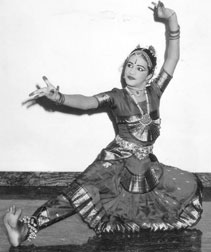The role of Adavus in classical Bharatha Natyam
by Subashini PATHMANATHAN
 In classical Bharata Natyam the dance is divided into three main
divisions -- Nirtha, Nirthya and Natya. The adavus are confined to the
Nirtha category, in classical Bharata Natyam. Nirtha means pure dance,
without revealing any meaning. All the basic aspects of dance such as
leg positions, hand positions, hand movements, body positions, neck
movements, body movements, eye movements and eyebrow movements are seen
in Nirtha, and Nirhya. Any dance, whether it is folk or classical or
ritual dance, the adavus are common. The term adavus are used in Kandyan
dance also. Adavus are the basic units for any dance forms. In classical Bharata Natyam the dance is divided into three main
divisions -- Nirtha, Nirthya and Natya. The adavus are confined to the
Nirtha category, in classical Bharata Natyam. Nirtha means pure dance,
without revealing any meaning. All the basic aspects of dance such as
leg positions, hand positions, hand movements, body positions, neck
movements, body movements, eye movements and eyebrow movements are seen
in Nirtha, and Nirhya. Any dance, whether it is folk or classical or
ritual dance, the adavus are common. The term adavus are used in Kandyan
dance also. Adavus are the basic units for any dance forms.
The beautiful movements of these pure nirtha rhythmic patterns were
called by Adiyarku Nallar (the 13th century commentator who wrote the
commentary on Sillapathykaram) as chokam. Adiyarku Nallar considered
pure nirtha as Chokam because; he felt that those who see the pure
Nirtha will be impressed by its beauty. That's why he called it Chokam.
Adavus comprises different body standing positions this is called
Isthana positions. Generally there are three basic body positions. One
is Sama Isthana position, (straight standing position) and other is the
Arimandi Isthana position, (half sitting position), and Mulu Mandi
Isthana (full sitting position).All the adavus are based on these three
basic positions.
Other technical aspects in adavus are Sari, Karana, Anga Karana, and
Desi Karana.
The terms Sari and Karanas are generally referred to as Sari Karana
or Karanams; this means the leg movements and hand movements are used
together in pure nirtha. Another term 'Angakaranam' is often used in
classical Bharatha Natyam. It means more than one Karanam joined
together in Angakaranam. After the sage Bharatha, who is believed to
have written the thesis 'Bharatha Sastra', several other writers have
written numerous thesis on dance, who used another term 'Desikaranam'.
Desikaranam means the jumping positions in dance.
Today in Bharata Natyam altogether there are eighteen varieties of
adavus.
These eighteen varieties of adavus are based on three basic body
Isthana positions. But the basic total number differs from text to text.
These eighteen varieties of adavus have given rise to the so called four
different styles in Bharata Natyam.
Thattu Adavu, Naattu Adavu, Kuthu Adavu, Thattu Mettu Adavu, Sarukai
Adavu, Sutru Adavu, Kuthu medu Adavu, Mei Adavu, Mandi Adavu, Marthitha
Adavu, Parchal Adavu, Pakka Adavu, and Korvai Adavu, Thandava Adavu, are
some of the common Adavus in classical Bharata Natyam
Basically all the styles use the same categories of Adavus and sub
Adavus, but the execution of the adavus differ from one style to
another.
The different styles originated because the gurus stationed in
different areas, used different techniques in the execution of adavus.
In classical Bharata Natyam there are four different styles namely
Pandanallur, Kaanchipuram, Thanjavoor and Vazhuvoor.
The Adavus comprise beautiful movements, systematic rhythmic
patterns, and high technical factors in dance. Adavus are the basic
foundation for the dance and it takes more time to learn it.
These pure Nirtha aspects of dance do not reveal any meaning. The
hand muthras or the hastas, used in Adavus do not indicate any meaning.
The muthras used in Adavus are generally called Ellil hands, or Nirtha
hands.
The Muthras used for Abinaya are called Tholil hands.
Ellil hands mean beauty hands, to show the beauty of the Adavus.
Tholil hands are used in abinaya to interpret the meaning of the song.
In the Nirtha thirteen muthras are used. These thirteen muthras comprise
some single hand muthras and some double hand muthras. In Adavus nearly
ten foot positions are used.
In Bharata Natyam one can see, the use of adavus in all items.
Allaripu and Jetheswaram are the two main traditional Nirtha adavu based
items. Even adavus play major role in the Nattuwangam sollukadus and
swaras in the song, or in other words beautiful variety of sequence of
adavus are compiled for nattuwangam sollukadus and swaras of the songs.
Varieties of adavus are called Korvai adavus. Korvai adavus are ended up
with theermana adavus.
The adavus strictly adhered to thala (tempo), kala (speed), and laya
(proper balancing between the thala, and kala). |

